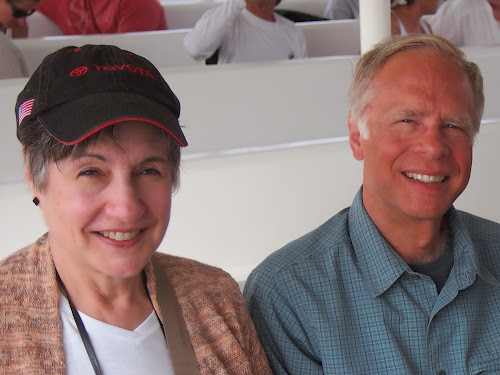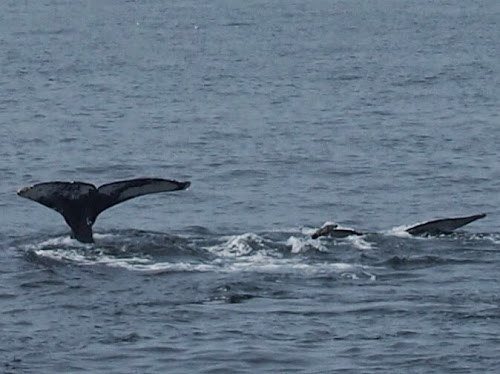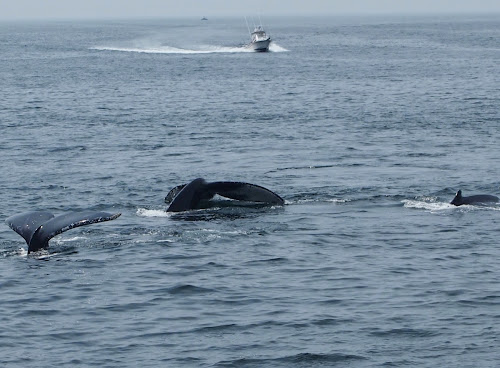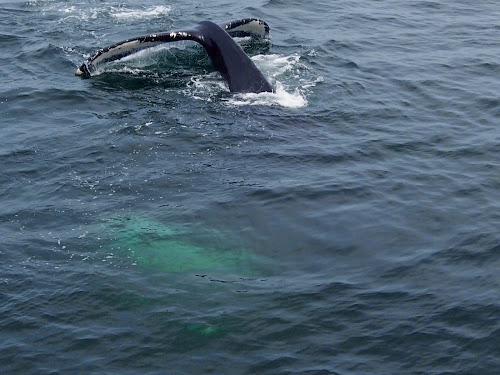The visit of Cousin Gwen was a wonderful excuse to go back to the sea, in search of Moby Dick. She had a long drive from Harrisburg and we wanted to make it worth her while!
We headed out to Provincetown, once a thriving fishing and whaling port, but now a colorful resort town out as far as you can go at the very fingertips of Cape Cod. It was a six icehouse town, with try-pots for rendering blubber to oil and fish processors providing full employment to four times today’s summertime population.
Amanda’s mother, Martha, forgot her hat and made a quick purchase before boarding our boat. It’s the first baseball cap she’s ever owned (and a nice one!).
Dennis, the ship’s naturalist, was also from Harrisburg. When he moved to Cape Cod in 1968 there were 60 fishing boats that went out from Provincetown harbor. Now there are ten. Dennis explained the difference between toothed whales and baleen whales, the latter of which don’t have teeth, but scoop up enormous amounts of fish in their mouths and squeeze the water out through large sheets of, well, baleen. As you can see from the chart, the ones with no teeth get very, very big. In fact, they are the largest creatures to have ever lived. They aren’t vegetarians, they just don’t bother with teeth. Interestingly enough, they evolved from toothed whales.
After coming out of Provincetown harbor and Cape Cod Bay, we were on the open ocean where we saw a Cory’s shearwater. It’s a pelagic bird that never ventures over land (except to nest).
We motored down along the outside of the Cape by Truro because the fish on which whales feed are plentiful there. We saw a Minke whale and a few Fin whales, including this one. The Fin whale is the one on the chart right above the Blue whale and is the second largest animal to have ever lived, at up to about 75 feet long or 85 feet in the Southern Hemisphere. Of course, we couldn’t get a true appreciation of size by only seeing what was above water.
This is what everyone wants to see on a whale watch – the classic fluke display of a humpback whale as it executes its dive after surfacing to breath. We encountered the humpback whales after running out to Stellwagen Bank, east of Boston and north of Cape Cod, where life abounds because of the modest water depth of 65 to 100 feet, as compared to the surrounding 300 feet. You can tell you’ve arrived because there are fishing boats all around you.
Every humpback whale has a unique pattern on its fluke and a large number have been named and catalogued so that individuals can be identified in the field from a guide maintained by naturalists that organizes the fluke patterns in order of the relative predominance of black or white in the pattern, much as a bird guide book is organized. The numbers of humpback whales have increased, so that it’s believed there are roughly 15,000 swimming the oceans.
The whale watching boats are remarkably close to the whales. The whale watching industry has developed protocols for behavior near the whales so as not to disturb them and, with other naturalists and nature organizations, they’ve applied the expertise of working with whales from whaling days to now help to conserve them. For instance, when whales become entangled in fishing gear, grappling harpoons must be used to bring human rescuers and untanglers up close to the whales, just as was done by whalers to deliver a mortal wound to a hunted whale.












